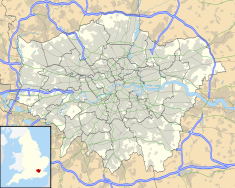Leighton House
| Leighton House Museum | |
|---|---|
 |
|
| Location |
Holland Park London, W14 United Kingdom |
| Coordinates | 51°29′54.89″N 0°12′11.12″W / 51.4985806°N 0.2030889°WCoordinates: 51°29′54.89″N 0°12′11.12″W / 51.4985806°N 0.2030889°W |
| Built | 1866–95 |
| Architect | George Aitchison |
| Governing body | Kensington and Chelsea Borough Council |
|
Listed Building – Grade II*
|
|
| Official name: Leighton House | |
| Designated | 30 August 1961 |
| Reference no. | 1191541 |
The Leighton House Museum is a museum in the Holland Park district of Kensington and Chelsea in London. The former home of the painter Frederic, Lord Leighton, it has been open to the public since 1929.
Built for Leighton by the architect and designer George Aitchison, it is a Grade II* listed building. It is noted for its elaborate Orientalist and aesthetic interiors. It is open to the public daily except Tuesdays, and is a companion museum to 18 Stafford Terrace, another Victorian artist's home in Kensington.
The first part of the house (2 Holland Park Road, later renumbered as 12) was designed in 1864 by the architect George Aitchison, although Leighton was not granted a lease on the land until April 1866. Building commenced shortly afterwards, and the house, which cost £4500 equivalent to £399,030 in 2015, was ready for occupation by the end of the year. The building is of red Suffolk bricks with Caen Stone dressings in a restrained classical style.
The architect extended the building over 30 years; the first phase was only three windows wide. The main room was the first floor studio, facing north, originally 45 by 25 feet, with a large central window to provide plenty of light for painting. There was also a gallery at the east end, and a separate staircase for use by models. The house was extended to the east in 1869–70. Additionally, a major extension was made in 1877–79: the two-storey "Arab Hall," built to house Leighton's collection of tiles collected during visits to the Middle East.
According to Aitchison and Walter Crane, the design was based on the palace of La Zisa in Palermo. The 17th-century tiles are complemented by carved wooden lattice-work windows of the same period from Damascus. There are also large 16th-century Turkish tiles. The west wall has a wooden alcove with inset 14th-century tiles.
...
Wikipedia

